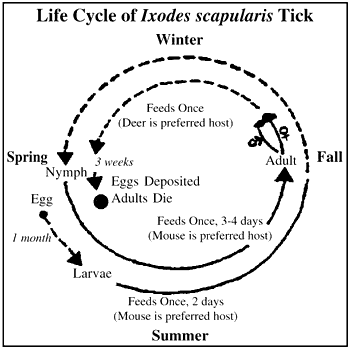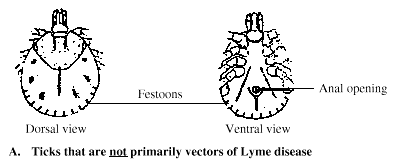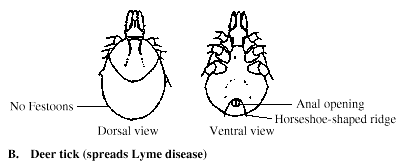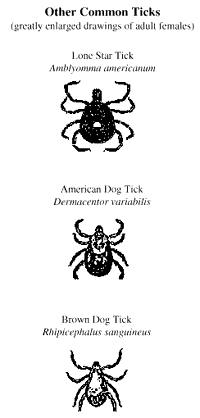
Lyme disease is caused by a bacterium transmitted by the deer tick, Ixodes scapularis (now known as the black-legged tick). The deer tick is found in high grassy areas, open fields, and in woods with a shrubby understory.
Ticks live in the shrubby understory of the forest. Ticks do not jump or fly--they wait on vegetation for an animal to brush against them. They then attach to the animal and insert their mouth parts (without burrowing beneath the skin). Following a blood meal, the tick swells to twice its normal size, and drops to the ground.
Description and Life Cycle
After hatching from an egg in late spring, the deer tick goes through three life stages: larva, nymph, and adult. Each stage requires a different host animal and feeds only once. Deer ticks take two years to complete their life cycle.
 |
Larvae - are very small (about the size of a pin head) and tan. They feed in late summer, near ground level, on mice, shrews, chipmunks, voles, and other small animals. Larvae can pick up the disease from an infected animal. Peak activity: August. |
 |
Nymphs - are the size of a poppy seed. They are biege, sometimes appearing transparent with a dark head. Nymphs feed from May through August on larger animals; including birds, racoons, opossum, squirrels, cats, dogs--and human beings. Peak activity: late May-June. |
 |
Adults - are the size of a sesame seed. Males are black; females have a brick-red abdomen and a black shield near the head. Females swell to 1/4 inch when fully engorged after feeding. Adults are active all winter long, as long as temperatures are above freezing. Adults feed primarily on deer, but will also attack cattle, horses, dogs, etc. Human beings are accidental hosts. Peak activity: October/November. |
Tick Identification
All ticks go through three growth stages (larva, nymph, adult) which differ in size. All stages have distinctive features that separate tick species. The following drawings are greatly enlarged to show characteristics used for identification of hard ticks:
Festoons--ridges on the edge of the lower abdomen. Deer ticks do not have festoons. Other common ticks do have festoons.
Anal Opening--looks like a navel on the ventral side of a tick. It tends to be in the center of the body of most ticks. On the deer tick, the anal opening is near the lower edge of the abdomen AND is surrounded by a horseshoe-shaped ridge.


Ticks: Disease Cycle
 The risk of being bitten by an infected deer tick is greatest
in the summer months, especially in May and June, when the
nymph stage is active. This is the time of year when people,
notably children, are most active outdoors. Make a habit of
thoroughly checking yourself and others for the tiny nymph
after outdoor activities and vacations.
The risk of being bitten by an infected deer tick is greatest
in the summer months, especially in May and June, when the
nymph stage is active. This is the time of year when people,
notably children, are most active outdoors. Make a habit of
thoroughly checking yourself and others for the tiny nymph
after outdoor activities and vacations.
About
25 to 50 percent of the deer ticks in New Jersey (depending
on where they are found) are infected with and able to transmit
Lyme disease. Newly hatched deer ticks do not initially carry
this disease; they pick it up from an infected animal. The
white-footed mouse is the primary carrier of the Lyme disease
bacterium. Once a tick picks up the bacterium, it will retain
it to its next stage, and be able to infect future host animals.
Research
indicates that a tick must feed for at least 24 hours to transmit
the disease bacterium.
Know the Early Signs of Lyme Disease
Lyme disease symptoms mimic many other diseases. About 70 percent of Lyme disease victims will develop a rash within two days to four weeks. If untreated, more severe symptoms may develop--sometimes months to years later.
If you suspect Lyme disease, consult a physician immediately. Symptoms that progress very quickly could be the result of Ehrlichiosis (H.G.E.), another tick-borne disease.
Tick Removal
If you find a tick on your body, remove it AS SOON AS POSSIBLE. Use tweezers ONLY. Bent "needle nose" tweezers work best. Do NOT use nail polish, vaseline, matches, or other methods (the latter procedures may traumatize the tick and cause it to regurgitate its gut contents). Grasp the tick with tweezers around its head, close to the skin. Pull it up and out slowly and firmly. Disinfect the bite afterward with antiseptic.
Save the live tick for identification by the RUTGERS COOPERATIVE EXTENSION office in your county.
Tick Prevention
Note:
* This insecticide is for use only by professional applicators.
For more information, contact: Rutgers Cooperative Extension office in your county or your local health department.
Ticks and Lyme Disease HOTLINE Numbers
Publication #: June 28, 1997
Deborah Smith-Fiola - County Agricultural Agent, Ocean County
This publication was made possible in part by a grant from the National Institute for Occupational Safety and Health Program on Agricultural Health Promotion Systems for New Jersey.
Disclaimer and Reproduction Information: Information in NASD does not represent NIOSH policy. Information included in NASD appears by permission of the author and/or copyright holder. More